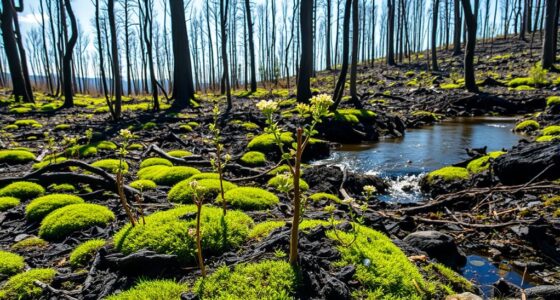Imagine discovering that many of the relationships you see in nature aren’t just about survival but about cooperation that benefits all involved. From tiny microbes to massive marine creatures, these partnerships often challenge your assumptions about competition and independence. They reveal a hidden web of connections that keep ecosystems thriving in unexpected ways. Curious to see how these alliances shape life on Earth? The stories behind these partnerships might just change how you view nature itself.
Microbial Alliances: Tiny Creatures With Big Impact
Microbial alliances are powerful examples of how tiny creatures can shape entire ecosystems. You mightn’t see these microbes, but they work tirelessly behind the scenes, transforming their environments. A growing area of research explores how these alliances can be harnessed to improve agricultural productivity and sustainability. Bacteria and other microorganisms team up with plants, animals, and even humans, forming partnerships that benefit everyone involved. For example, certain bacteria live in our guts, helping us digest food and synthesize vital nutrients. In soils, microbes break down organic matter, releasing nutrients that plants need to grow strong. These alliances influence climate regulation, soil fertility, and disease resistance.
The Fungal Networks Beneath Our Feet
Beneath the surface of the soil, vast networks of fungi stretch out, connecting plants and trees in a hidden web of communication and support. These mycelial networks transfer nutrients, water, and chemical signals between plants, helping them share resources and warn each other of danger. Paint Sprayer Reviews & Buying Guides can provide insights into the importance of proper tools for maintaining healthy outdoor environments. When one tree is attacked by pests, for example, it sends signals through the fungal network, alerting neighboring trees to prepare defenses. This underground system isn’t just a support network; it’s a communication highway that fosters resilience and cooperation in the forest.
Plants and Animals Working Hand in Hand
Just as fungi form networks that link plants underground, many plants and animals have evolved to work together in ways that benefit both. For example, pollinators like bees and butterflies visit flowers to collect nectar, helping plants reproduce by spreading pollen. Some plants depend on animals to disperse their seeds; animals eat fruits and carry seeds far from the parent plant, ensuring new growth in different areas. In return, animals gain nutritious food, like nectar or fruit. Certain plants even offer shelter or nesting sites for animals, creating mutualistic relationships. These partnerships demonstrate the importance of symbiotic relationships in maintaining healthy ecosystems and improving survival chances for both parties, demonstrating how interconnected life in nature truly is.
Mutual Benefits in Coral Reefs
Coral reefs exemplify a remarkable partnership where both corals and their associated organisms benefit immensely. As a result, these vibrant ecosystems thrive, supporting countless marine species.
Corals provide a protected environment and essential nutrients for tiny algae called zooxanthellae, which live within their tissues. In return, these algae photosynthesize, producing energy that fuels coral growth and reef development.
This mutualism helps corals build massive structures that serve as habitats for fish, invertebrates, and other marine life. You’ll notice that without this partnership, reefs would struggle to survive, as corals rely heavily on their algal partners for sustenance.
Together, they create a dynamic balance that sustains the diverse and productive ecosystems you see in coral reefs around the world.
Parasitic Partnerships That Flip the Script
While mutualism often dominates marine partnerships, some relationships flip the script, turning parasitism into a strategic advantage. In these cases, one organism benefits at the expense of another, yet it still plays a vital role in the ecosystem.
Take the parasitic isopod, for example. It invades fish gills, feeding on their blood and tissue, weakening but not killing the host. Surprisingly, this relationship can regulate fish populations, preventing overpopulation and maintaining balance.
Similarly, certain parasitic barnacles latch onto whales, feeding on their blood while affecting their movement minimally. These partnerships demonstrate that parasitism isn’t always purely destructive; it can influence population dynamics, promote diversity, and even foster resilience in marine environments.
Sometimes, flipping the script turns parasitism into a subtle but vital ecological tool. Understanding risk management in ecological systems reveals how such parasitic relationships can contribute to overall ecosystem stability.
Unexpected Collaborations in Symbiotic Relationships
Sometimes, species form unexpected alliances that challenge traditional views of symbiosis. These collaborations go beyond the usual roles of mutualism or parasitism, creating surprising partnerships. For example, certain ants protect aphids from predators, gaining honeydew in return. Additionally, some fish serve as cooperation techniques, cleaning parasites off larger marine animals, earning food and protection. These relationships demonstrate that nature often blurs the lines of typical interactions. You might think symbiosis is straightforward, but these examples show how species can benefit each other in unconventional ways.
The partnerships reveal adaptability and complexity in ecosystems. Unexpected collaborations remind you that in nature, cooperation can emerge in the most unlikely circumstances, fostering survival and resilience for all involved.
Conclusion
You’ve seen how these surprising partnerships keep ecosystems thriving, from tiny microbes to massive coral reefs. By working together, species adapt, survive, and even flourish in ways you might not expect. Symbiosis shows that cooperation often beats competition, creating resilient, diverse environments. Next time you observe nature, remember these incredible collaborations—you’re witnessing the power of connection that sustains life on Earth. It’s a reminder that teamwork truly shapes our world.







